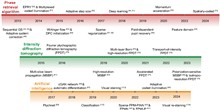 View fulltext
View fulltext
Quantitative phase imaging (QPI), promoted by advances in digital holography and computational imaging, is a label-free microscopy approach to investigating phase objects that are optically transparent or translucent, such as cells, tissues, or industrial microstructures. As a computational imaging technique, Fourier ptychographic microscopy (FPM) has rapidly emerged as a powerful tool to achieve wide-field and high-resolution QPI. It can recover the quantitative phase maps of optical path length delays introduced by unlabeled samples, providing an objective measure of refractive index distribution or surface topography of samples. Over the past 12 years, ongoing advances in FPM hardware and software have led to numerous applications in biomedicine and industrial fields. Here, we review the field of QPI based on FPM (FPM-QPI), starting with the underlying principles, followed by a summary of representative advances in both algorithms and imaging models, and ending with the breadth of applications. Finally, we conclude with the emerging challenges and opportunities for the deployment of FPM-QPI as well as the application trends that can expand the scope and utility even further.
Computational imaging enables high-quality infrared imaging using simple and compact optical systems. However, the integration of specialized reconstruction algorithms introduces additional latency and increases computational and power demands, which impedes the performance of high-speed, low-power optical applications, such as unmanned aerial vehicle (UAV)-based remote sensing and biomedical imaging. Traditional model compression strategies focus primarily on optimizing network complexity and multiply-accumulate operations (MACs), but they overlook the unique constraints of computational imaging and the specific requirements of edge hardware, rendering them inefficient for computational camera implementation. In this work, we propose an edge-accelerated reconstruction strategy based on end-to-end sensitivity analysis for single-lens infrared computational cameras. Compatibility-based operator reconfiguration, sensitivity-aware pruning, and sensitivity-aware mixed quantization are employed on edge-artificial intelligence (AI) chips to balance inference speed and reconstruction quality. The experimental results show that, compared to the traditional approach without hardware feature guidance, the proposed strategy achieves better performance in both reconstruction quality and speed, with reduced complexity and fewer MACs. Our single-lens computational camera with edge-accelerated reconstruction demonstrates high-quality, video-level imaging capability in field experiments. This work is dedicated to addressing the practical challenge of real-time edge reconstruction, paving the way for lightweight, low-latency computational imaging applications.
Imaging through strongly scattering media noninvasively faces a key challenge: reconstructing the object phase spectrum. Speckle correlation imaging (SCI) effectively reconstructs the amplitude spectrum but struggles with stable and accurate phase spectrum reconstruction, particularly in variable or background-light-interfered scenarios. In this study, we proposed a speckle spectrum autocorrelation imaging (SSAI) approach for complex strongly scattering scenarios. SSAI employs the spectrum autocorrelation of centroid-aligned speckle images for independent and stable reconstruction of the object phase spectrum, markedly reducing interference from medium dynamics and object motion. Then, SSAI reconstructs the object spectrum by combining the object phase spectrum with the object amplitude spectrum recovered from the speckle autocorrelation. In the experimental validation, we compared SSAI and SCI in reconstructing stationary and moving objects hidden behind dynamic media, both with and without background light interference. SSAI not only exhibits stability and fidelity superior to SCI but also functions in scattering scenarios where SCI fails. Furthermore, SSAI can reconstruct size-scaling objects hidden behind dynamic scattering media with high fidelity, showing significant scalability in complex scenarios. We expect this lensless and noninvasive approach to find widespread applicability in biomedical imaging, astronomical observations, remote sensing, and underwater detection.
As a novel imaging paradigm, single-pixel imaging (SPI) has shown significant potential across various fields. However, intricate nonlinear reconstruction algorithms, such as compressive sensing or deep neural networks, are crucial to enable real-time imaging. In general, the former incurs substantial reconstruction time, and the latter often results in substantial energy consumption. Optical neural networks (ONNs) offer a promising alternative because of the intrinsic alignment between the sampling of SPI and the fully connected layers in ONNs. Nevertheless, achieving nonlinear reconstruction via ONNs remains a challenging task since the nonlinear activation functions still pose significant difficulties. Here, we propose an all-optical ONN architecture with controllable nonlinear order that mitigates the reliance of ONNs on nonlinear activation functions. Following the scheme of compressive SPI, we demonstrate the fitting capability of the structure by two linear tasks—compressive SPI and linear-edge extraction—and two nonlinear tasks—nonlinear-edge extraction and handwritten dataset classification. Experimental results show that this structure has good fitting capabilities for both regression tasks and classification tasks, even with low order.














